CSS Tricks for FlexboxCSS tricks for flexbox are essential to adjust, design, and position the container using flexbox and other CSS Flexbox trick properties. CSS tricks property and multiple properties values are used for flex box design and its data. We can use CSS tricks to set alignment, position, space, and other designs for flexbox. The following CSS tricks format is used to design flexbox.
Flex DirectionThe flex-direction is used to get the direction of the container inside the flexbox. We can set the containers as per requirement. Syntax: The following syntax uses the CSS tricks for flexbox. We can use other CSS properties for the flex-direction. Description:
Examples of Flex-directionThe following examples show the flexbox with display Flex properties and values. We can adjust content, alignment, and directions. Example 1: The following examples show the flex-direction with row, alignment, and content with the start position by default. Output: The output shows the flexbox with CSS tricks. 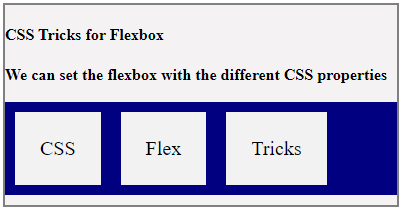
Example 2: The following examples show the flex-direction with row reverse, and the content shows the start position by default. The reverse row shows the end-to-start tag with horizontal alignment. Output: The output shows the flexbox with CSS tricks. 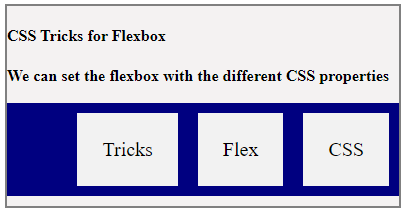
Example 3: The following examples show the flex-direction with column, alignment, and content with the start position by default. The column shows start-to-end tags with vertical alignment. Output: The output shows the flexbox with CSS tricks. 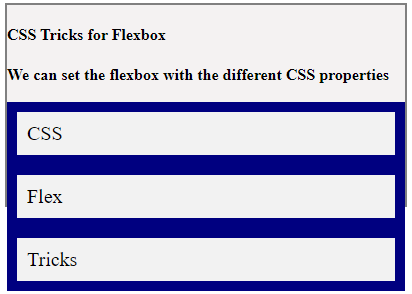
Example 4: The following examples show the flex-direction with column reverse, and alignment shows with the start position by default. The column reverse shows the end-to-start tag with vertical alignment. Output: The output shows the flexbox with CSS tricks. 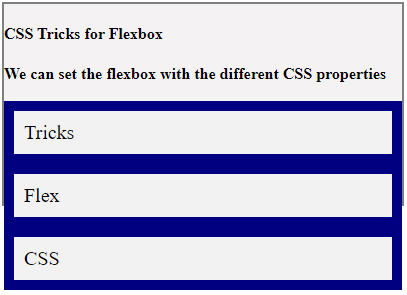
Flex Alignment TricksThe flex uses alignment and content position with CSS tricks or properties. Syntax: The following syntax uses the CSS tricks for flexbox alignment. Description:
ExamplesThe following examples show the content and flexbox position with different values. Example 1: The following examples show the flex-direction with the row, alignment with the end and justify-content shown with the end position. Output: The output shows the flexbox with CSS tricks. 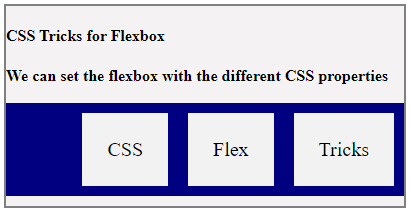
Example 2: The flexbox shows the container in the center position with the justify-content property. Output: The output shows the flexbox with CSS tricks. 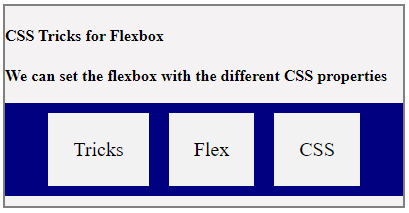
Example 3: The flexbox uses the justify-content property to show the container with the space around the tag. Output: The output shows the flexbox with CSS tricks. 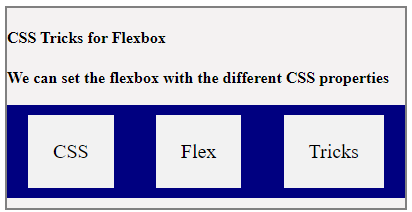
Example 4: The flexbox uses the justify-content property to show the container with the space around the tag. We can use the display with an inline flex value of the property. Output: The output shows the flexbox with CSS tricks. 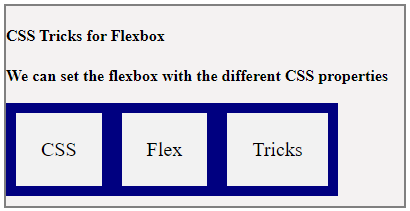
CSS Tricks for Flexbox MarginWe can set the margin and padding to Flexbox and its child box using CSS properties. We can set basic flexbox CSS tricks and their value for the display box. After, add the CSS property to set the margin of the flexbox's child element. Syntax The following syntax is used on the child element of the flexbox to set the margin. ExamplesThe following examples set the margin and design using CSS tricks with child elements. Example 1: The following example sets the margin and padding of the first element of the flexbox container. We can set the margin value, font size, and background colour to match the required value. Output: The output shows the margin of the first element. 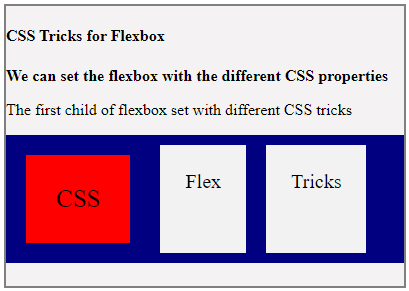
Example 2: The following example sets the margin and padding of the third element of the flexbox container. We can set the value of the margin-auto with the different background colours. Output: The output shows the margin of the first element. 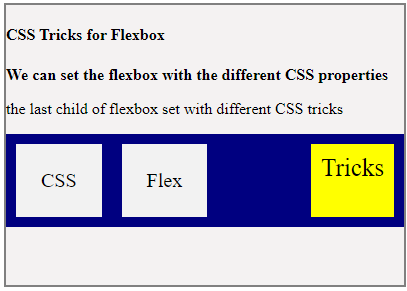
Example 3: The following example sets the margin and padding of the last element of the flexbox container. Output: The output shows the margin of the first element. 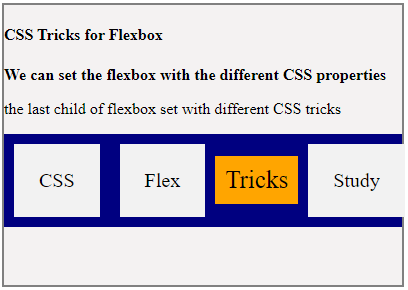
ConclusionThe CSS tricks use the properties and their value to set the flexbox design. We can use multiple designs and tricks to get the required format of the CSS flexbox.
Next TopicText Italic in CSS
|
 For Videos Join Our Youtube Channel: Join Now
For Videos Join Our Youtube Channel: Join Now
Feedback
- Send your Feedback to [email protected]
Help Others, Please Share










